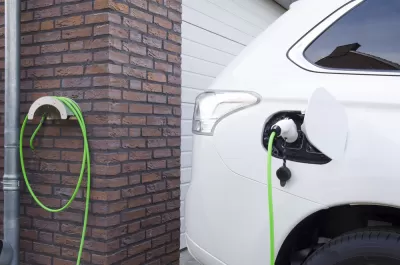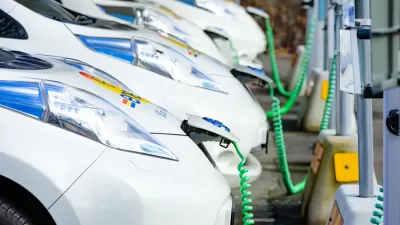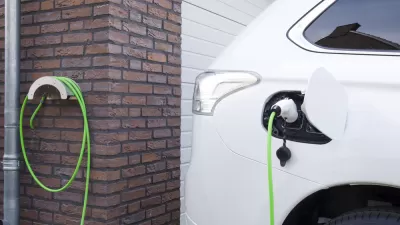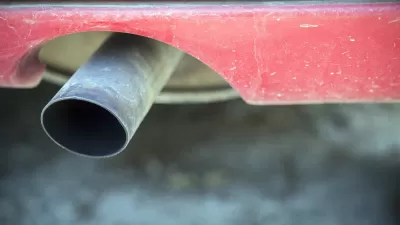Two UC Berkeley economists evaluated whether to charge electric vehicles a mileage fee since they pay no fuel taxes. A study from the Mineta Institute evaluated the impact of new EV registration fees and increased fuel taxes in California.

Two studies into the costs of electric vehicles were released in July. Laura Bliss, CityLab’s west coast bureau chief, reports on an economics study by the Energy Institute at BerkeleyHaas (source article), while Melanie Curry, editor of Streetsblog California, evaluates the findings of a Mineta Transportation Institute on the financial impact of zero-emission vehicles in California.
Last year saw a record 81 percent increase in electric vehicle (EV) sales, and those sales will likely increase as more electric models with greater range enter dealers' showrooms and more public EV charging infrastructure is installed to keep them powered. "But are all those Bolts, Leafs, and Teslas paying their fair share for the asphalt they drive on?" asks Bliss, noting that these vehicles pay no fuel taxes, the primary source of revenue for the Highway Trust Fund which will exhaust its current funding at the end of September 2020.
In a new working paper for the National Bureau of Economic Research [a non-profit, non-partisan organization dedicated to conducting economic research], Lucas Davis, a professor of business and technology and a director of U.C. Berkeley’s Energy Institute, and James Sallee, a professor in the school’s Department of Agricultural and Resource Economics, estimate that while the U.S. does indeed forgo millions in tax revenue thanks to EVs, instituting a special tax on electric vehicles might produce unwanted side effects. [Full report accessible as (PDF) via the Energy Institute].
How much funding is forgone in gas tax revenue, and how is it regressive?
Davis and Sallee estimate about $250 million a year, based on vehicle substitution trends and average miles driven. That’s a fairly modest hit, but per EV, it seems weightier: $318 annually, according to their estimates.
What’s more, Sallee and Davis estimate that two-thirds of those foregone resources comes from households that make more than $100,000 in annual income, since EVs tend to be more expensive to purchase than conventional cars and are disproportionately driven by more affluent people. This suggests that the under-taxation of zero-emissions cars has a “regressive” effect—it hurts poorer Americans more than rich folks.
The purpose of the study was to evaluate charging EVs what the researchers refer to as a "mileage tax," aka road usage charge, mileage-based user fee, or vehicle miles traveled fee. Only one state has such a fee – Oregon, which has been in operation since July 2015 for a limited number of vehicles, although many states have conducted pilot programs.
In the long run, however, a mileage fee for all vehicles is probably the best answer of all, the researchers conclude. Unlike the venerable gas tax, a mileage fee could vary by time and location, and it could be priced to account for more of the negative social impacts of driving.
Perhaps that’s the most useful takeaway of this paper. The gas tax—the baseline for how much driving “should” be taxed—is so vastly underpriced that trying to compute a fair way to layer additional fees on top of it becomes complicated, quickly.
While some experts suggest that statewide mileage fee for all vehicles is about a decade away, it may be more practical to require only electric vehicles to participate in a program, as UC Davis researchers advised the California legislature earlier this year.
What about EV registration fees?
Since October 2018, at least 21 state legislatures haven't waited for a mileage fee to ensure that electric vehicles, and even gas tax-paying hybrid vehicles in many states, contribute to road costs by requiring that they pay a special registration fee, according to the National Conference of State Legislatures. California joined that list in April 2017 with the passage of Senate Bill 1.
Beginning July 1, 2020, "owners of electric vehicles will begin paying a Road Improvement Fee of $100, an amount that was supposed to approach what the average gas car driver pays in gas taxes annually," writes Melanie Curry, editor of Streetsblog California. In addition, SB 1 subjected all light-duty vehicles to a new Transportation Improvement Fee, which took effect January 1, 2018, which ranges from $25 to $175, depending on the value of the vehicle.
Three researchers who have studied the ins and outs of gas taxes for years–Martin Wachs, professor emeritus at the UCLA Luskin Center, Hannah King of UCLA, and Asha Weinstein Agrawal Weinstein of the Mineta Institute–have just published a report estimating how much revenue that is likely to be.
The study is particularly significant in the sense that it is evaluated both increases to gas and diesel excise taxes, diesel sales taxes, and the two new registration fees (see Table 1 [pdf] on pg. 2), all of which are indexed to inflation, that are in the Road Repair and Accountability Act of 2017. California's gas and diesel excise tax increased by 12 cents and 20 cents per gallon, respectively, on Nov. 1, 2017. On July 1, the gas tax increased by another 5.6 cents, making California the state with the highest gas tax at 61.2 cents per gallon, per API. Inflation adjustments will occur annually.
But even with the highest fuel taxes in the country, indexed for inflation, fuel tax revenues will fall due to projected adoption of non-gas tax-paying vehicles.
Like the Berkeley study, the Mineta study looks at foregone gas (and diesel) tax due to increased sales of electric vehicles. Last year, plug-in vehicles accounted for 7.8 percent of light-duty vehicle sales. Former Gov. Jerry Brown signed an executive calling for 5 million zero-emission vehicles on the road by 2030.
The key finding of the study is that revenue from the two new registration fees will more than compensate for the loss of fuel tax revenue as the proportion of electric vehicles increase in the Golden State.
"The California Transportation Commission continues to explore other ways to raise transportation revenue, such [as] through road-user charges that drivers would pay per mile driven," concludes Curry.
But this study shows that even without such a system, there will be a continuous source of money to maintain and improve California’s highways, streets, and roads–and that it was a very good idea for the legislature to make sure S.B. 1 included a way for electric vehicles to contribute.
Related in Planetizen:
-
Mileage Fee or Annual Fee for Electric Vehicles? January 11, 2019
- Should Electric Vehicles Be Taxed or Subsidized? July 1, 2015
FULL STORY: Should Electric Vehicle Drivers Pay Per Mile?

Study: Maui’s Plan to Convert Vacation Rentals to Long-Term Housing Could Cause Nearly $1 Billion Economic Loss
The plan would reduce visitor accommodation by 25,% resulting in 1,900 jobs lost.

North Texas Transit Leaders Tout Benefits of TOD for Growing Region
At a summit focused on transit-oriented development, policymakers discussed how North Texas’ expanded light rail system can serve as a tool for economic growth.

Why Should We Subsidize Public Transportation?
Many public transit agencies face financial stress due to rising costs, declining fare revenue, and declining subsidies. Transit advocates must provide a strong business case for increasing public transit funding.

How to Make US Trains Faster
Changes to boarding platforms and a switch to electric trains could improve U.S. passenger rail service without the added cost of high-speed rail.

Columbia’s Revitalized ‘Loop’ Is a Hub for Local Entrepreneurs
A focus on small businesses is helping a commercial corridor in Columbia, Missouri thrive.

Invasive Insect Threatens Minnesota’s Ash Forests
The Emerald Ash Borer is a rapidly spreading invasive pest threatening Minnesota’s ash trees, and homeowners are encouraged to plant diverse replacement species, avoid moving ash firewood, and monitor for signs of infestation.
Urban Design for Planners 1: Software Tools
This six-course series explores essential urban design concepts using open source software and equips planners with the tools they need to participate fully in the urban design process.
Planning for Universal Design
Learn the tools for implementing Universal Design in planning regulations.
City of Santa Clarita
Ascent Environmental
Institute for Housing and Urban Development Studies (IHS)
City of Grandview
Harvard GSD Executive Education
Toledo-Lucas County Plan Commissions
Salt Lake City
NYU Wagner Graduate School of Public Service





























